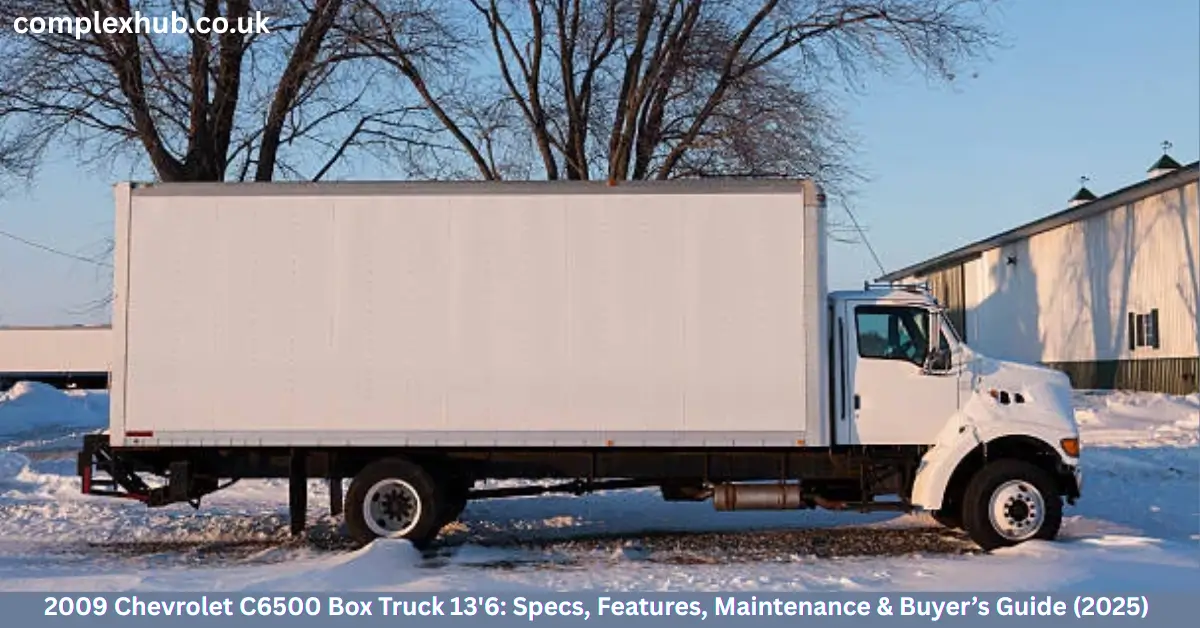
1. Introduction
If you need a reliable medium-duty box truck that balances payload, durability, and ease of service, the 2009 Chevrolet C6500 Box Truck 13’6 remains one of the most practical choices on the used market. Built on Chevrolet’s Kodiak/TopKick medium-duty chassis, the C6500 was designed for demanding commercial use — from moving companies and local delivery fleets to contractors and specialty upfitters. In 2025, many businesses still prefer it for its straightforward design, widely available parts, and proven diesel engines.
This guide covers everything you need to know: exact specifications, engine and transmission options, performance and fuel considerations, who should buy one, common issues and maintenance, where to buy, pricing expectations, and how it stacks up vs. competitors.
2. What Is the 2009 Chevrolet C6500 Box Truck 13’6?
The 2009 Chevrolet C6500 is part of GM’s C-Series Kodiak/TopKick medium-duty lineup (Class 6–7 range). The “13’6”” in the model name refers to a factory or common aftermarket cargo box length of 13 feet 6 inches — a sweet spot for urban and short-regional routes that need substantial volume without the complexity of larger Class 8 rigs. The Kodiak/TopKick series offered multiple cab and chassis configurations tailored for box trucks, roll-backs, refrigerated vans, and specialty conversions.
3. Key Specifications of the 2009 Chevrolet C6500
Engine options (common):
- 6.6L Duramax LMM V8 diesel — widely used in Kodiak/TopKick applications, popular for cleaner emissions and strong mid-range torque. Output commonly quoted around ~260–300 hp depending on tune and application.
- 7.8L Duramax (LG4/LF8) inline-6 diesel — higher displacement inline-6 used in heavier duty spec packages with torque ratings that can reach up to 860 lb-ft in certain tune levels; output ranges historically from ~195–300 hp depending on calibration.
Transmission:
- Allison automatic transmissions (2000/2400 series or similar heavy-duty Allison automatics) are commonly fitted for smooth, reliable shifting under load.
GVWR / Class:
- Typical Gross Vehicle Weight Rating (GVWR) ranges for C6500 configurations run between 19,500–25,950 lbs (Class 6). Some brochures and chassis specs list GVWR options starting around 22,000 lbs depending on upfit and configuration. Always verify the VIN/door placard for the exact GVWR on any unit.
Cargo box dimensions (typical for 13’6 box):
- Length: 13 ft 6 in (interior)
- Width (approx): 8.0–8.5 ft
- Interior height (typical): 6.5–8 ft depending on box spec and roof options
Chassis & body: rear-wheel drive, heavy-duty frame rails designed to accept a wide range of bodies (aluminum, fiberglass-reinforced panels, or steel), with hardwood floor as common factory or aftermarket option.
Fuel type: Diesel (Duramax variants)
Typical payload: Depending on GVWR, box construction, and curb weight, useful payloads commonly exceed 8,000–14,000 lbs, but exact payload depends on your truck’s configuration and conversions — check the vehicle placard to calculate real payload.
4. Performance and Drivability
Horsepower & Torque
The C6500’s available diesel options make it a workhorse for city deliveries and regional hauls. The 6.6L Duramax typically delivers strong horsepower in the ~260–300 hp range with torque in the ~520 lb-ft neighborhood in pickup/truck calibrations used in Kodiak applications, while the 7.8L inline-6 provides more torque at lower RPMs — valuable when hauling heavy payloads or towing. Exact outputs vary by engine tune and whether the unit has emissions-related equipment fitted.
Transmission & drivability
Paired with Allison automatics, the C6500 is easy to drive for operators with limited medium-duty experience. The Allison transmissions are engineered for stop-and-go urban work as well as highway runs, and they tend to reduce driver fatigue compared with manual gearboxes. Expect predictable gearing for loaded starts and good engine braking capability in moderate grades.
Fuel economy
Medium-duty diesel fuel economy varies widely with load, route profile, and driving style. Expect 7–11 mpg as a realistic range in mixed urban/regional use for a 2009 C6500 with typical box configuration — heavier loads and stop-start routes will push the number toward the lower end. These figures align with real-world reports for similar Kodiak/TopKick chassis from the era.
5. Cargo Space and Build Quality
Box construction & materials
The 13’6 box is commonly built from aluminum panels (for corrosion resistance) or fiberglass-reinforced panels, and many fleets specify hardwood plank flooring for durability under heavy loads. The box simplicity makes it easy to outfit with shelving, e-track tie-downs, and custom racking for trade-specific work.
Rear access & options
Common options include roll-up doors, barn doors, or liftgates (electric/hydraulic) depending on the customer’s needs. Interior LED lighting and tie-downs are typical aftermarket additions for safety and cargo security. These modifications make loading/unloading safer and faster for moving companies and delivery fleets.
6. Who Should Use the 2009 Chevrolet C6500?
Best fits:
- Local & regional freight/logistics operators who need a medium-duty chassis with strong payload and low operating complexity.
- Moving companies handling residential and small commercial moves — 13’6 is often large enough for most household loads while remaining maneuverable.
- Construction & contracting teams that require a secure, heavy-duty haul platform for tools and materials.
- Specialty upfit projects (refrigerated boxes, mobile workshops, concession/food trucks) where a robust chassis simplifies conversion.
The C6500 is a flexible platform that adapts well to many commercial roles — its main advantage is a proven chassis and the availability of aftermarket conversion options.
7. Advantages of the 2009 Chevrolet C6500 Box Truck 13’6
- Durability & robust chassis design. Built for commercial cycles and frequent daily use.
- Proven diesel powertrains. The Duramax family is known for long life and solid mid-range torque.
- Allison transmission availability. Reduced driver training time and reliable shifting under load.
- Availability of parts & service. Because GM chassis and Duramax engines were widely used, parts remain relatively accessible.
- Versatility. Box, refrigerated, flatbed, and specialty conversions are straightforward for this chassis.
8. Challenges and Things to Consider
Fuel economy vs. modern trucks
While diesel durability is excellent, fuel economy won’t match modern medium-duty models that use advanced engine management, aerodynamics, or hybridization. Expect lower mpg compared with the newest Class 6/7 trucks.
Emissions and compliance
Depending on your state or municipality, emissions equipment and retrofits may be required, and some clean-air zones restrict older diesels. Check local regulations — you may need DPF, upgraded emissions systems, or aftermarket solutions to meet current standards.
CDL & operator considerations
If the configured GVWR pushes beyond local thresholds (often 26,000 lbs in the U.S. for CDL triggers, but check local rules), you may need drivers with a commercial driver’s license. Verify the truck’s placard and local laws before you schedule routes.
9. Maintenance and Common Issues
Common wear points
- Turbocharger wear (especially in high-mileage diesel engines) — check for shaft play and oil contamination.
- Transmission service needs — Allison automatics are durable but require fluid and filter changes at recommended intervals.
- Brake system wear — heavier loads require frequent brake inspections, especially if the truck uses hydraulic brakes rather than air.
- Suspension bushings and spring fatigue on high-cycle trucks.
Preventive maintenance checklist
- Oil & filter changes every 5,000–10,000 miles depending on duty cycle and oil type.
- Transmission fluid and filter every 30,000–60,000 miles (follow Allison recommendations).
- Inspect brake pads/drums & lines monthly for heavy use.
- Fuel filter replacement every 20,000 miles or per service schedule.
- Regular cooling system and belt checks to avoid overheating on heavy hauls.
- Recordkeeping: maintain a service log — resale value and longevity correlate strongly with documented preventive care.
With diligent maintenance, well-spec’d Duramax engines and Allison transmissions can exceed 300,000 miles for commercial duty — many fleet trucks reach high mileages when properly cared for.
10. Buying a Used 2009 Chevrolet C6500
What to inspect before purchase
- VIN & title check — confirm no salvage or flood history.
- Service history — prioritize trucks with consistent service records.
- Engine health — listen for unusual noises, check smoke patterns on start, review compression/leakdown if possible.
- Transmission performance — test under load for harsh shifts or slipping.
- Brake and suspension condition — check for uneven wear or leaks.
- Body & box condition — look for corrosion on frame rails, box seams, and flooring rot.
- Verify GVWR & payload calculations — know your limits before bidding.
Where to buy
- Commercial truck marketplaces (TruckPaper, CommercialTruckTrader).
- Local dealers and certified used truck sellers (often provide inspection and limited warranties).
- Auctions — can yield bargains but riskier without inspection.
- Fleet retirements & local rental fleets — often well-maintained but may have high cycle counts.
Price ranges (2025 market)
Used pricing varies by condition, mileage, upfits, and region. As of recent listings and market snapshots, expect a broad range from roughly $15,000 to $30,000+ for well-maintained 2009 C6500 box trucks — well-equipped or low-mile examples can command higher prices. Always compare comparable listings and factor in upfit costs.
11. 2009 Chevrolet C6500 vs Competitors
Chevy C6500 vs Ford F-650
- Price & parts: C6500 often costs less used and GM parts are widely available.
- Engine choices: Ford F-650 offers different drivetrains (including gasoline V-8 and diesel), but C6500’s Duramax options remain competitive for torque and serviceability.
Chevy C6500 vs Freightliner M2
- Chassis purpose: Freightliner M2 is purpose-built for vocational use and may offer more modern drivetrain tech on newer models; the C6500’s advantage is simplicity and lower acquisition cost.
Chevy C6500 vs International DuraStar
- Resale & parts: International trucks often have strong resale value in certain markets; Chevy can be easier/cheaper to service in general automotive dealer networks.
Bottom line: the C6500 stands out for cost of ownership, parts availability, and straightforward diesel powertrains — a pragmatic choice for many small-to-medium enterprises.
12. Is the 2009 Chevrolet C6500 Still a Good Investment in 2025?
Yes — if you match the truck to the right use case and perform disciplined maintenance. The C6500’s sweet spot is operators who need a medium-duty chassis without the purchase price and complexity of newer Class 6/7 trucks. For many small fleets, a well-maintained 2009 C6500 offers:
- Lower upfront cost than newer trucks
- Robust payload and proven engine/transmission combos
- Easier access to parts and many qualified mechanics
However, if your operation demands best-in-class fuel efficiency, the latest telematics, or compliance with the strictest urban emissions zones, a newer chassis or alternative powertrain may be a better long-term investment. Consider total cost of ownership (TCO): acquisition + maintenance + fuel + downtime.
13. Conclusion
The 2009 Chevrolet C6500 Box Truck 13’6 remains a practical, adaptable, and affordable medium-duty truck for a wide range of commercial applications in 2025. Its strengths are a durable chassis, familiar Duramax diesel powertrains, Allison automatic transmissions, and plentiful upfit possibilities. For small fleets, movers, contractors, and specialty operators who value reliability and lower acquisition costs over the newest fuel-saving tech, the C6500 is a proven performer.
Before buying, confirm the specific engine and GVWR for the unit, inspect service history, and determine whether emissions or licensing rules in your operating area require upgrades or a CDL. With careful selection and preventive maintenance, a 2009 C6500 can be a dependable backbone for your business operations for many years to come.
14. FAQs
Q1: What is the payload capacity of the 2009 Chevrolet C6500 Box Truck 13’6?
A: Payload varies by GVWR and upfit, but many configurations can carry 8,000–14,000+ lbs of useful load. Always calculate payload by subtracting curb weight from the truck’s GVWR on the VIN placard.
Q2: Does the 2009 C6500 require a CDL to operate?
A: It depends on GVWR and local regulations. If GVWR exceeds your jurisdiction’s CDL threshold (commonly 26,000 lbs in the U.S. for certain classes), a CDL is required. Many C6500 configs stay under that threshold, but confirm with the placard and local law.
Q3: How fuel-efficient is the 2009 C6500?
A: Expect roughly 7–11 mpg depending on load, route, and engine/transmission combo. Heavier loads and city stop/start work push the figure lower.
Q4: What engines were available for the 2009 C6500?
A: Common options include the 6.6L Duramax V8 and the 7.8L Duramax inline-6 (LG4/LF8 family), plus other diesel choices depending on original spec. Power outputs vary by tune.
Q5: What is the typical price range for a used 2009 C6500 in 2025?
A: Market data shows a general range of $15,000–$30,000+ depending on condition, mileage, and upfit. Check local listings and auction results for precise regional pricing.
Read More :- www Doodflix Pro (2025)






